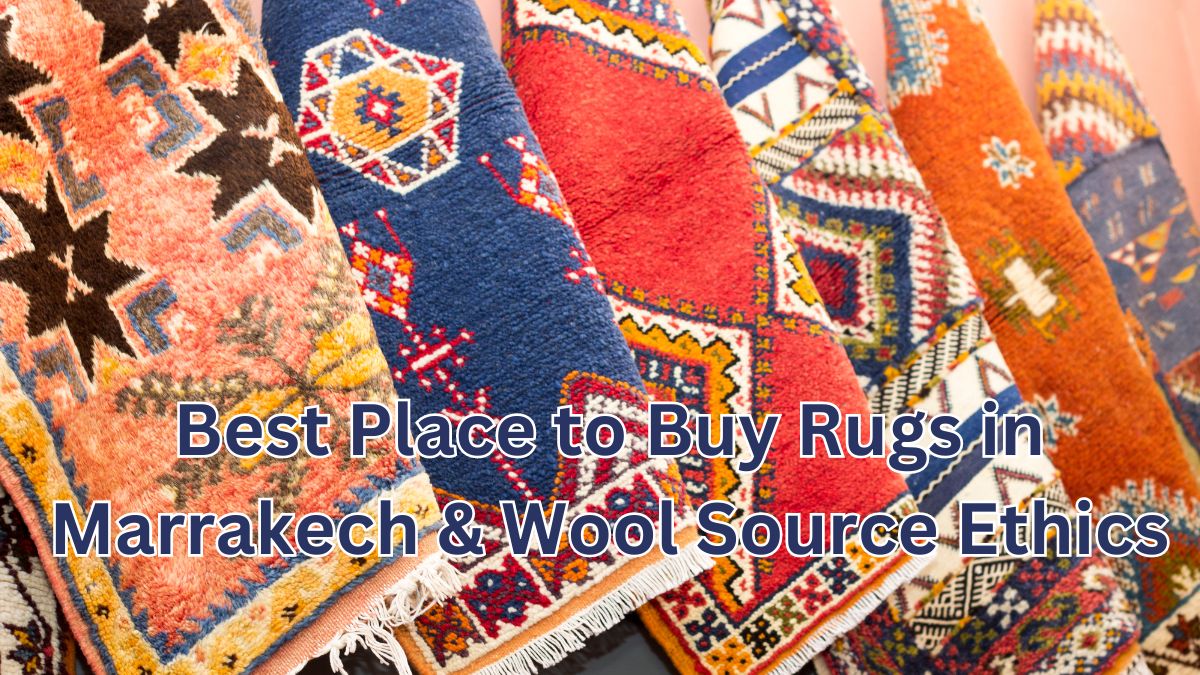I. Introduction
Marrakech, a city draped in the hues of tradition and adorned with the threads of cultural heritage, stands as a testament to Morocco’s rich artistic tapestry. Amidst the bustling souks and the scent of exotic spices, Marrakech beckons travelers into a world where every rug woven is a story told. This introduction unveils the enchanting charm of Marrakech, a city where the very essence of artistry permeates the air.
In the heart of Marrakech’s vibrant streets lies a craft deeply embedded in the city’s soul: rug-making. For centuries, artisans here have transformed threads of wool into intricate masterpieces, each rug reflecting the city’s history, culture, and creativity. This art form, passed down through generations, not only adorns homes but also weaves the narrative of Morocco’s rich past.
However, beneath the surface of this artistic splendor lies an ethical dilemma that echoes through the alleys of Marrakech: the sourcing of wool. This dilemma, rooted in the choice between wool obtained from live animals and that from deceased animals, raises profound questions about ethics, sustainability, and tradition. As we delve into the world of Marrakech’s rug-making, we confront this ethical crossroad, exploring the intricate balance between preserving ancient craft and respecting the lives that contribute to its creation. Buy rugs in Marrakech becomes a journey of understanding this delicate balance and appreciating the craftsmanship involved.
Join us as we unravel the threads of this complex tapestry, where tradition meets ethical consciousness in the colorful alleys of Marrakech. Whether you’re a traveler seeking a unique souvenir or an art enthusiast looking to buy rugs in Marrakech, this exploration guides you through the ethical nuances of this ancient craft. Understanding the choices involved in buying rugs in Marrakech is not just about acquiring a piece of art; it’s about supporting ethical practices and preserving the cultural heritage that makes Marrakech’s rugs truly exceptional.
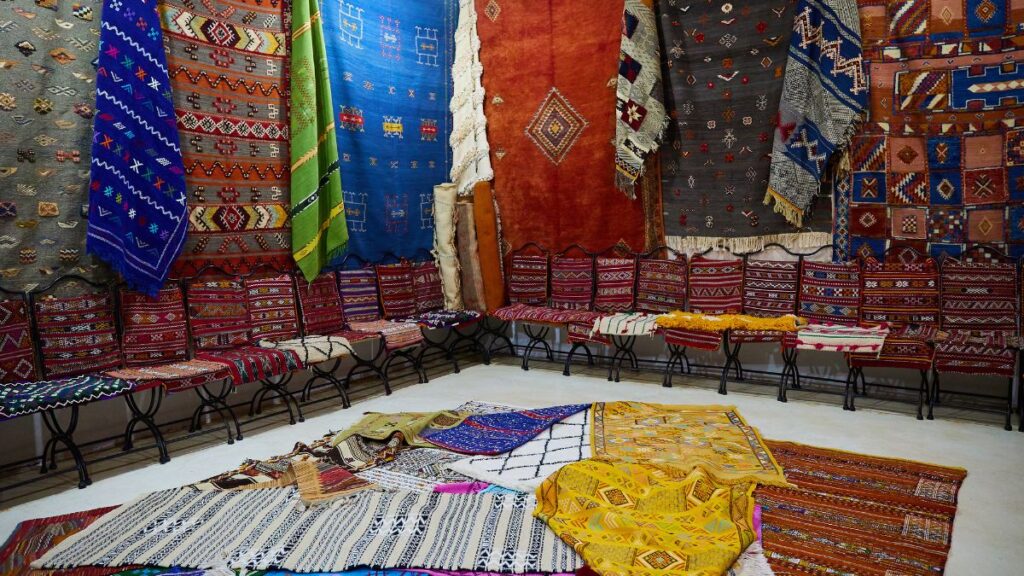
II. Exploring the Best Places to Buy Rugs in Marrakech
A. Souk des Tapis
1. Vibrant Atmosphere and Variety of Rugs:
Nestled within the heart of Marrakech, Souk des Tapis emanates a vibrant aura. Its narrow alleys adorned with rugs of myriad colors and patterns create a mesmerizing tapestry. Visitors are greeted by a kaleidoscope of Berber, Boucherouite, and contemporary designs, showcasing the rich diversity of Moroccan rug craftsmanship. Buy rugs in Marrakech and immerse yourself in this vibrant display of artistic heritage.
2. Interacting with Local Artisans:
One of Souk des Tapis’ unique charms lies in the opportunity to interact with local artisans. Visitors can witness the weaving process firsthand, gaining insight into the meticulous techniques that breathe life into each rug. Engaging with these artisans adds a personal touch, allowing buyers to appreciate the dedication and skill invested in every creation. When you buy rugs in Marrakech, these interactions enhance the significance of your purchase, connecting you directly with the rich cultural heritage of Moroccan rug-making.
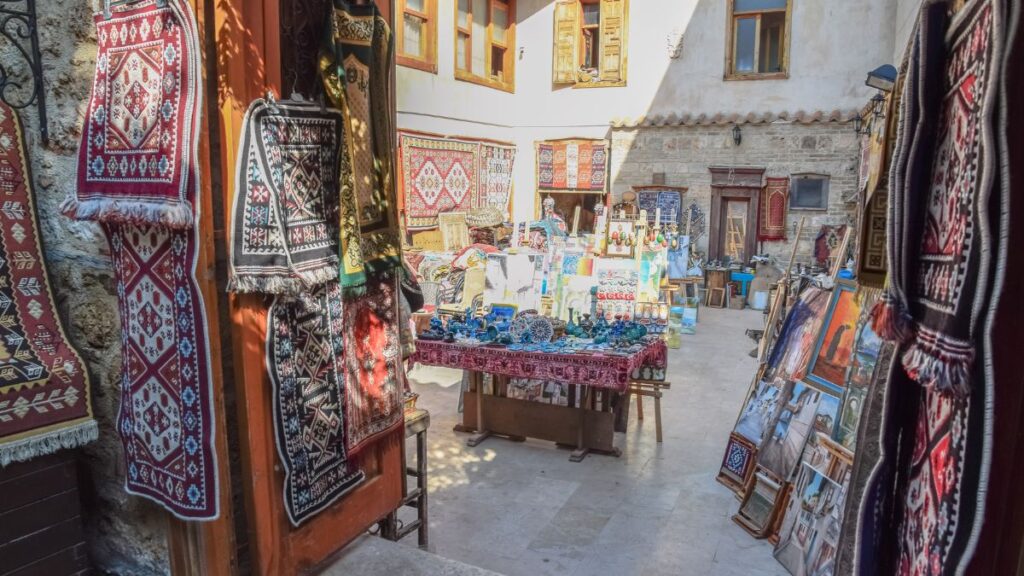
B. Ben Youssef Carpet Center
1. Educational Aspect and Traditional Craftsmanship:
The Ben Youssef Carpet Center stands as an educational beacon, preserving the essence of traditional rug-making techniques. Visitors embark on a journey through time, delving into the intricacies of hand-weaving, dyeing, and pattern creation. The center serves as a vital custodian of Marrakech’s rug heritage, fostering an understanding of the art form’s historical significance. When you buy rugs in Marrakech, this educational experience enriches your appreciation for the craft, connecting you deeply with the cultural legacy of Moroccan rugs.
2. Range of Rugs from Traditional to Contemporary:
Beyond its educational role, the Ben Youssef Carpet Center boasts a diverse range of rugs. From classic Berber designs that echo ancient traditions to contemporary pieces that blend Moroccan heritage with modern aesthetics, the center offers a spectrum of choices. Buyers can explore rugs that suit various tastes, ensuring a seamless fusion with their living spaces. Buying rugs in Marrakech becomes an exciting journey at the Ben Youssef Carpet Center, where tradition meets contemporary elegance, catering to diverse preferences and interior styles.
C. Souk Cherifa
1. Curated Selection and Traditional-Modern Blend:
Souk Cherifa epitomizes the elegance of curation. Its selection of rugs seamlessly intertwines traditional motifs with modern sensibilities. Each rug is carefully chosen, reflecting a harmonious blend of heritage and contemporary style. The souk’s curated ambiance elevates the buying rugs in Marrakech experience, enticing visitors with a selection that exemplifies timeless elegance.
2. Shopping Experience and Customer Service:
Souk Cherifa offers more than just rugs; it provides an enchanting shopping experience. Knowledgeable staff guide buyers through the collection, sharing insights into the rugs’ origins and symbolism. Exceptional customer service ensures that every visitor’s journey is both delightful and informative, fostering a sense of appreciation for the artistry behind each rug. When you buy rugs in Marrakech at Souk Cherifa, you not only acquire a beautiful piece but also gain a profound understanding of the craftsmanship and cultural significance woven into each rug.
D. El Badii Palace Rugs
1. Unique Offerings of Vintage and Antique Rugs:
El Badii Palace Rugs takes buyers on a captivating voyage through history. Its unique offerings include vintage and antique rugs, each with a tale to tell. These rugs, weathered by time yet retaining their allure, showcase the enduring charm of Moroccan craftsmanship. Buyers can acquire rugs that bear the marks of generations, adding a touch of antiquity to their homes. When you’re looking to buy rugs in Marrakech, El Badii Palace Rugs offers a remarkable selection steeped in history and character.
2. Historical Significance and Influence on Rugs:
Located near the historic El Badii Palace, this store’s rugs are deeply influenced by Marrakech’s cultural legacy. The designs often echo architectural motifs and artistic elements found in the city’s monuments. Exploring these rugs becomes a journey through Marrakech’s history, allowing buyers to bring home not just a rug but a piece of the city’s soul. Buying rugs in Marrakech at El Badii Palace Rugs offers an unparalleled opportunity to enrich your home with the cultural heritage of Morocco, connecting your space with the city’s profound historical significance.
E. Mustapha Blaoui
1. Eclectic Collection of Rugs and Moroccan Artifacts:
Mustapha Blaoui’s store is a treasure trove of Moroccan artistry. Its collection spans far beyond rugs, encompassing a diverse array of Moroccan artifacts. Rugs, both vintage and contemporary, share space with exquisite pottery, intricate lanterns, and traditional textiles. This eclectic blend provides buyers with a holistic Moroccan experience, inviting them to explore the country’s artistic heritage.
2. Store’s Reputation and Appeal to Interior Designers and Collectors:
Mustapha Blaoui’s store has garnered international acclaim, becoming a haven for interior designers and collectors. Its reputation for authenticity and quality precedes it, drawing enthusiasts from around the world. The store’s allure lies not only in its individual pieces but in the cohesive ambiance, allowing buyers to envision Moroccan-inspired spaces. For interior designers and collectors, Mustapha Blaoui’s store is a sanctuary where creativity finds its muse.
In this exploration of Marrakech’s rug markets, each venue offers a unique perspective on the city’s rug-making traditions. From the bustling Souk des Tapis to the curated elegance of Souk Cherifa, and from the educational heritage of the Ben Youssef Carpet Center to the historical influence at El Badii Palace Rugs, and the eclectic blend of artistry at Mustapha Blaoui’s store, Marrakech’s rug-buying experience is as diverse and vibrant as the city itself.
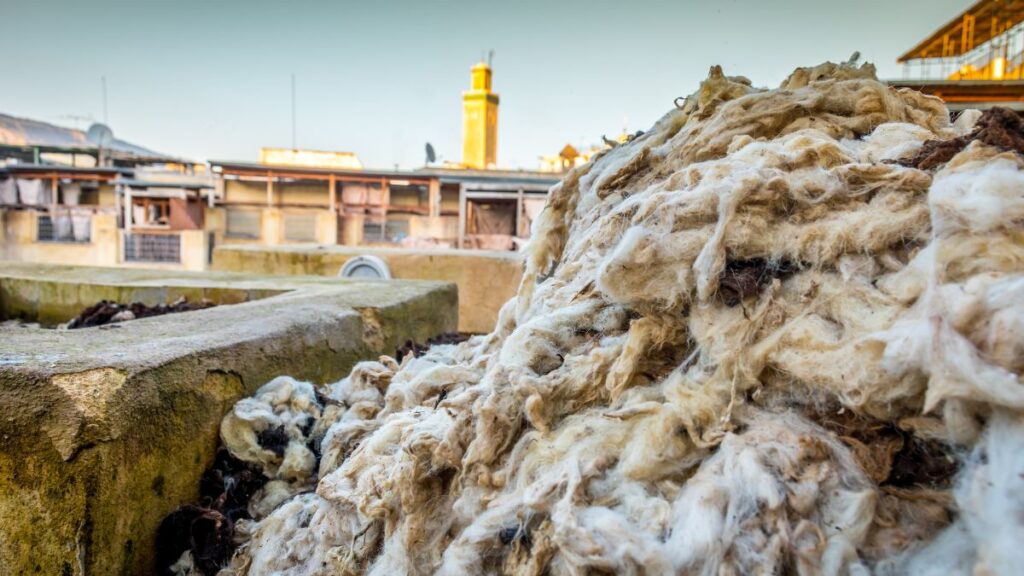
III. Ethical Considerations: Wool from Live Animals vs. Wool Obtained from Dead Animals
A. Wool Sourcing: The Basics
1. Unique Offerings of Vintage and Antique Rugs:
El Badii Palace Rugs takes buyers on a captivating voyage through history. Its unique offerings include vintage and antique rugs, each with a tale to tell. These rugs, weathered by time yet retaining their allure, showcase the enduring charm of Moroccan craftsmanship. Buyers can acquire rugs that bear the marks of generations, adding a touch of antiquity to their homes. When you’re looking to buy rugs in Marrakech, El Badii Palace Rugs offers a remarkable selection steeped in history and character.
2. Historical Significance and Influence on Rugs:
Moroccan rugs, also known as Berber rugs, hold significant historical and cultural importance in Morocco and have influenced the broader world of interior design. Here are some key aspects of their historical significance and influence:
- Symbolism: Many Moroccan rugs feature intricate geometric and abstract designs. These designs often carry symbolic meanings, representing elements of the weavers’ daily lives, spirituality, and the natural world.
- Tradition of Storytelling: Berber rugs are often referred to as “storytelling rugs” because the designs can tell a story or convey a message. They serve as a way for Berber women to pass down their cultural and tribal knowledge through the generations.
- Influence on Modern Design: Moroccan rugs have had a significant impact on contemporary interior design. Their minimalist and geometric designs have gained popularity in modern decor. The use of these rugs in contemporary settings can add a touch of cultural authenticity and a warm, inviting atmosphere.
- Artistic Expression: Many contemporary artists and designers have drawn inspiration from Moroccan rugs, incorporating their motifs and color palettes into various forms of art and fashion.
- Cross-Cultural Exchange: The popularity of Moroccan rugs has sparked cross-cultural exchanges between Morocco and other countries. This exchange has not only enriched the design world but also fostered a deeper understanding of Moroccan culture.
B. Ethical Implications of Using Wool from Live Animals
1. Humane Treatment of Animals and Sustainable Practices:
Ethical wool sourcing places a strong emphasis on the humane treatment of animals. Shearing, when performed by skilled professionals, ensures minimal stress and discomfort for the animals. Additionally, ethical practices encompass the animals’ overall well-being, including appropriate food, shelter, and veterinary care. Sustainable practices are integrated, emphasizing the ecological balance and reducing the environmental footprint of wool production. When you choose to buy rugs in Marrakech from ethically sourced wool, you are supporting practices that prioritise animal welfare and environmental sustainability.
2. Positive Environmental Impact of Ethical Wool Sourcing:
Ethical wool sourcing contributes positively to the environment. Well-cared-for animals in sustainable farming systems help maintain healthy ecosystems. Ethical practices often involve natural and organic farming methods, reducing the usage of harmful chemicals. Moreover, these systems encourage biodiversity, fostering a balanced environment for both animals and plant life. Buying rugs in Marrakech crafted from ethically sourced wool not only enhances your living space but also contributes to the preservation of nature, making your choice both stylish and environmentally responsible.
C. Challenges and Concerns with Wool Obtained from Dead Animals
1. Ethical Concerns Related to the Use of Deceased Animals for Wool:
Using wool from deceased animals raises ethical questions, especially concerning the circumstances of the animal’s death. Ensuring that the animal died naturally and was not subjected to any harm is a significant challenge. Ethical sourcing requires thorough oversight to guarantee the source’s integrity and maintain ethical standards. When considering where to buy rugs in Marrakech, understanding the ethical considerations around wool sourcing becomes a crucial aspect of your purchase decision.
2. Potential Environmental and Health Issues Associated with This Practice:
The use of wool from deceased animals may pose environmental and health concerns. Improper disposal or handling of deceased animals can lead to pollution and health hazards. Additionally, without stringent regulations and ethical oversight, this practice may encourage unhealthy farming practices, impacting both the environment and consumer health. It’s essential for consumers looking to buy rugs in Marrakech to be aware of these issues, ensuring their choice aligns with ethical values and contributes positively to both the environment and animal welfare.
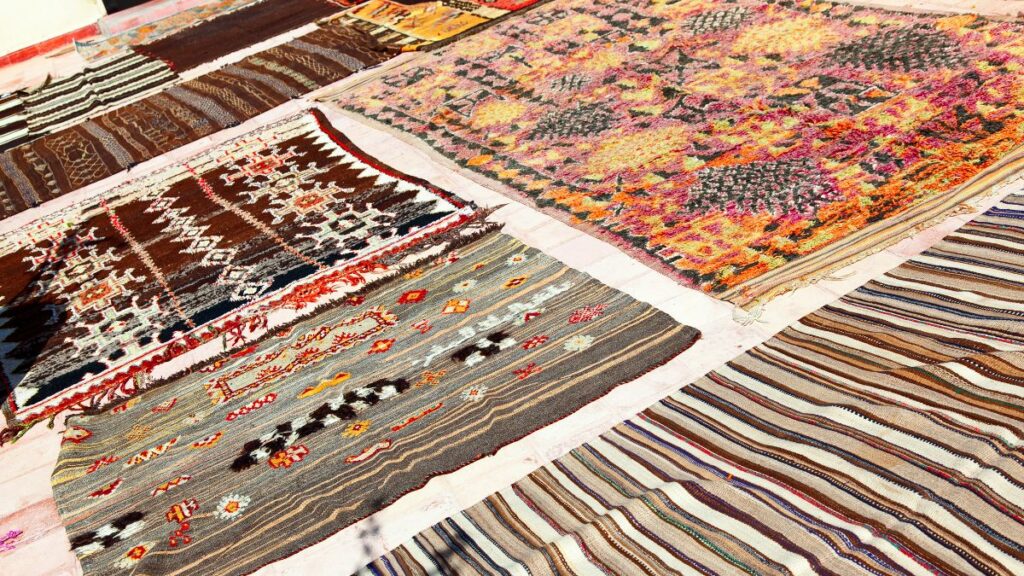
V. Conclusion
A. The Allure of Marrakech’s Rug Market:
Marrakech’s rug market, a labyrinth of colors, textures, and traditions, stands as a testament to the city’s artistic brilliance. In the bustling souks, where ancient craftsmanship meets modern sensibilities, visitors are captivated by a mesmerizing array of rugs. Each rug, meticulously woven, tells a story of Marrakech’s heritage, its vibrant culture, and the skill of its artisans. The market breathes life into living spaces, transforming houses into homes and adding a touch of Moroccan magic to every room. When you buy rugs in Marrakech, you are not just acquiring a piece; you are embracing Marrakech’s rich artistic heritage.
B. The Significance of Ethical Considerations:
Amidst the allure, it’s vital to recognize the significance of ethical considerations. Beyond the patterns and colors lies a profound responsibility towards the animals whose wool adorns these rugs and the environment from which these materials are sourced. Ethical practices ensure that the beauty of these rugs doesn’t come at the cost of ethical integrity. Choosing rugs made with compassion and sustainability not only preserves the welfare of animals but also upholds the ethical standards of a conscientious society. When you buy rugs in Marrakech with these considerations, you are contributing to a cycle of compassion, enriching your home with ethical and beautiful pieces.
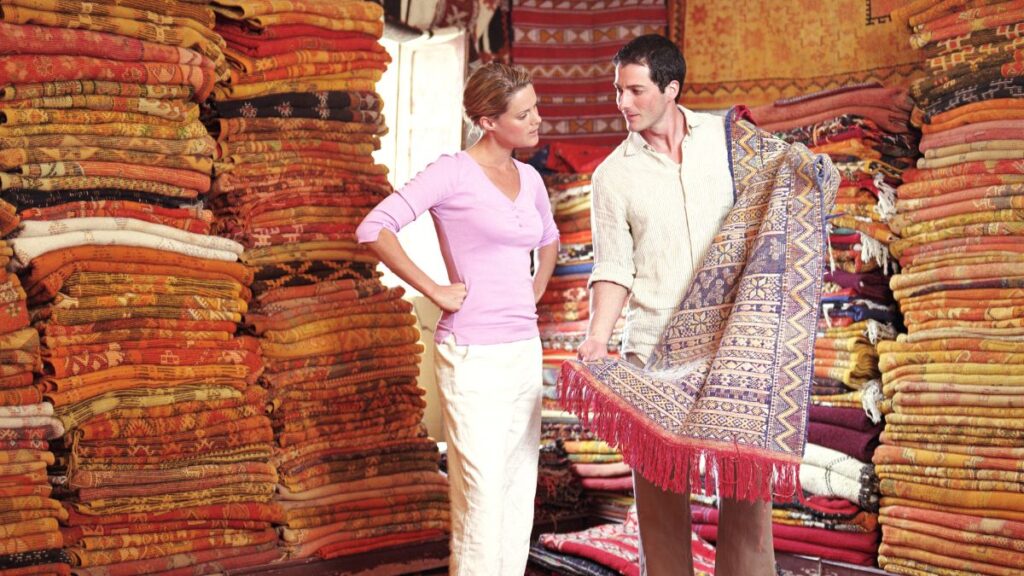
C. Supporting Ethical Practices and Sustainable Traditions:
As you embark on your journey to acquire a piece of Marrakech’s artistry, I urge you to be a conscious consumer. Support ethical practices and sustainable traditions. Your choice is not just a personal statement but a contribution to a global movement towards responsible consumerism. By valuing transparency, ethical sourcing, and the preservation of traditional craftsmanship, you are not only investing in a rug but also in a future where art, ethics, and sustainability coexist harmoniously. Buying rugs in Marrakech becomes a meaningful endeavor, bridging the gap between artistic appreciation and ethical responsibility.
In the vibrant threads of Marrakech’s rugs, let us weave a tapestry of compassion, understanding, and respect. Embrace the beauty of Moroccan rugs, not just for their aesthetic appeal, but for the ethical principles they embody. Together, let’s create a world where every rug not only adorns our homes but also reflects our commitment to a better, more compassionate tomorrow.
 TripAdvisor
TripAdvisor




